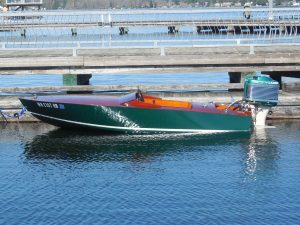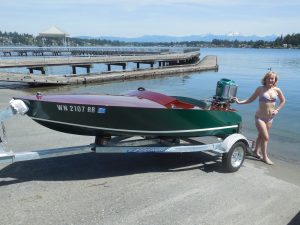Bill and Linda's Glen-L Squirt, Part 2
Posted by BillW2 on Jun 3rd 2016
When we wrote part 1 about our Glen-L Squirt, we didn't know there would be a part 2. But here is a follow-up to the December 2015 piece about our Glen-L Squirt.
This time we have a performance report and some in-the-water pictures. In keeping with the 1950's classic boat theme, we really needed a picture with the Glen-L Poster Girl. But she must be retired by now, so here is Linda filling in as the poster girl, grandmother version.
It seems that a lot of amateur boat builders want to "improve" the beautifully designed Glen-L boats. Well, we weren't much different, so with apologies to the Glen-L family, here is some of the thinking (or lack of) that resulted to changes to this Squirt.
When I was 10 years old, I wanted a Glen-L Squirt. I'm not sure if there were horsepower ratings for outboard boats in 1957, but if there were, at age ten I did not give it much thought. Some of you are thinking "he still doesn't". Anyway, the boat of my dreams would have a brand new, for 1957, Mercury Mark 55, of 40 horsepower. Why not go for broke and have the best, since this boat existed only in my ten year old imagination?
Fast-forward over a half century and there is a new Glen-L Squirt sitting in my shop. I seemed to still have a ten year old kid inside me, and he still wanted the Mk 55 motor. I did point out to him (the 10 year old) that 40 horsepower might be a lot for a Squirt. Old guys talk to themselves sometimes. Then he brought up the fact that motors do have a throttle, so you don't have to actually use full power. "True" I says, "but what about all that weight in the back of a tiny boat?" And he says we should compare the weights of some alternatives. For instance, a modern 20 hp 4-stroke outboard, of any manufacture, weighs very nearly the same as a Merc Mk55. Actually, the Mk55 weighs only 20 or 25 pounds more than some modern 9.9 hp motors. The 10 year old kid was quick to point out this Squirt was lengthened and beefed up a bit. He sealed the deal by reminding me this "vintage" boat sort of looks like an old-time race boat; it was necessary to have a vintage Merc.
If you are an old guy with a ten year old kid still inside you, it might be best to ignore him.
The Squirt was stretched 15 inches by means of adding 5 inches to each frame bay. The stem was lengthened 5 inches where it bolts to the keel. At the time we didn't know that Glen-L does not recommend this, so as they say, ignorance is bliss. But it seemed to work out okay. The frames then looked a bit far apart, so we beefed up the keel, battens, chines and sheer members a little. We opted for the 3/4 inch plywood transom, instead of 1/2 inch and made the top transom frame member one piece side to side. The coamings, as designed, lend a lot of strength to the transom, but even so we added a small upside down transom knee on each side at the sheer, and also a small splash well.
The smallest built-in type gas tank readily available is a Moeller 12 gallon plastic one. It's behind the seat with a filler cap on the deck, and it feeds the engine thru a Racor filter/water separator. Twelve gallons is a bit much (72 pounds) but it doesn't have to be full. The marine starting battery weighs 43 pounds and is mounted at the forward frame with extended cables. Lighter batteries are available, but this one at a forward location helps a lot in preventing porpoising in this tiny boat. It has Teleflex rack and pinion steering with a Glenwood racing wheel. The steering cable cannot make the bend at the dashboard, so the cable is extra long and loops around under the front deck. Teleflex steering cables will not fit the tilt tube of old Mercury outboards, so there is a steering tube attached with brackets to the motors tilt tube.
The motor is shimmed up to a transom height of 16.5 inches per the Mercury handbook. The first tilt pin hole gives a little nose down trim, and the second a little nose up, so neither is parallel to the boat bottom. So far, we have only run it with two adults on board, combined weight of 280 pounds. In smooth water with half fuel, and the first tilt pin hole, it rides very nicely. But it's right on the edge of porpoising. Any small swell or boat wake will start a gentle porpoise, although that improves with fuel burn off. If it begins to porpoise, it can usually be stopped with a little speed change. Top speed is 38 mph now, with a 12-pitch bronze propeller. The Mercury prop slip calculator says we can get a little more speed with higher pitch in the prop. But that's a problem with vintage Mercury motors; it's hard to locate the right propeller. The Squirt takes light chop pretty well when slowed to 20 to 25 mph. As it slows below planning speed, the following wave does not wash over the transom, as I thought it might. And at rest or moving slowly it is much more stable than I would have expected. But it should be confined to fairly protected water. Linda says it is probably a good thing that I was not turned loose in this boat when I was ten years old.
We were glad to read in the newsletter that Mr. Witt is doing well now.




